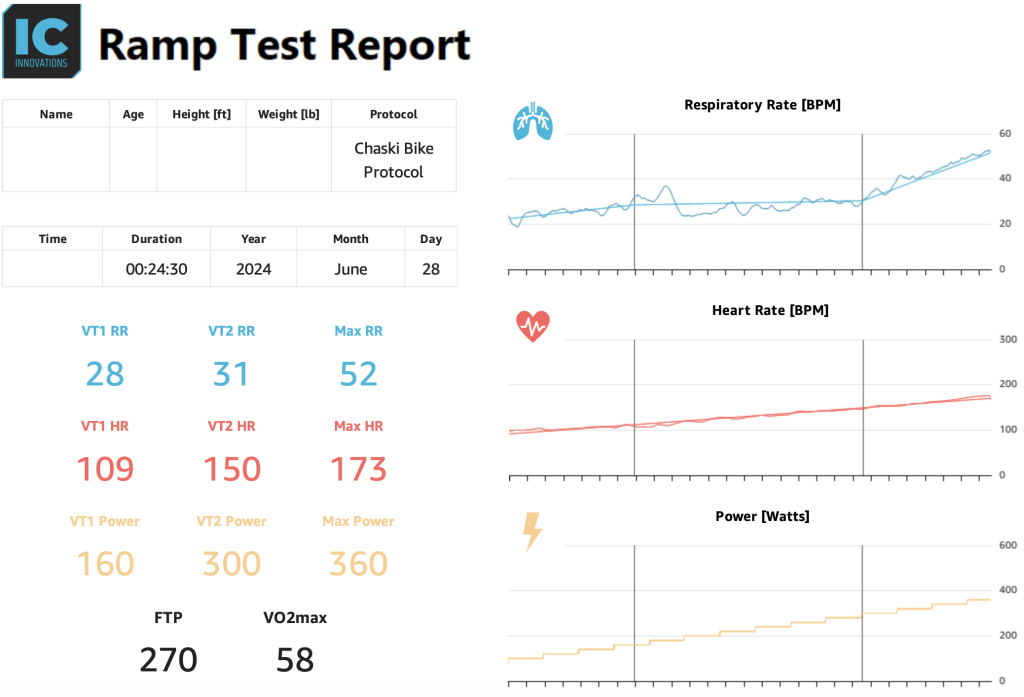Proper rest and recovery are essential components of any successful training program. At CHASKi, we believe that understanding when to take a break can help athletes avoid the pitfalls of overtraining. This post explores the principles of recovery, the differences between overreaching and overtraining, and how respiratory rate (RR) can serve as an indicator of readiness. We’ll also take a closer look at a case study of a cyclist to illustrate these concepts.
The Principle of Recovery
Recovery is the period during which the body repairs and strengthens itself after exercise. This phase is crucial for muscle repair, glycogen replenishment, and overall restoration of energy levels. Without adequate recovery, athletes risk diminishing returns from their training efforts and increased susceptibility to injuries.
Overreaching vs. Overtraining
While both overreaching and overtraining are conditions of excessive physical stress, they are different in terms of severity and recovery time.
- Overreaching: A short-term condition characterized by an accumulation of training stress. Symptoms include fatigue, decreased performance, and general tiredness. With proper rest, recovery from overreaching typically takes a few days to a week.
- Overtraining: A more severe, long-term condition resulting from prolonged overreaching without adequate recovery. Symptoms include chronic fatigue, significant performance decline, mood disturbances, and a higher risk of injury and illness. Recovery from overtraining can take several weeks to months.
The Role of Respiratory Rate in Monitoring Fatigue
Respiratory rate (RR) is emerging as a valuable metric for assessing an athlete’s readiness to train. RR measures the number of breaths taken per minute and reflects the body’s metabolic demands. As physical exertion increases so do oxygen requirements and the need to eliminate CO2, and in turn respiration rate increases to meet these demands. Therefore, an elevated RR at a given intensity can indicate the metabolic demands of the body are higher (i.e. the body is working harder) to maintain that intensity, suggesting fatigue.
Case Study: A Cyclist’s Experience
To illustrate these principles, let’s examine the case of a cyclist who performed two incremental maximal tests to assess ventilatory thresholds in terms of RR, heart rate, and power output.
- Test 1: March 12, at the beginning of the training cycle
- Race: comprised of 145 miles and 13,000 ft of climbing, with a duration of 9.5 hours
- Test 2: June 28, at the end of the training cycle


Analyzing the Results
The second test showed a lower power output at VT2 showing his anaerobic capacity decreased.

The second test showed an increased RR at every intensity level. This indicates that his metabolic demand was higher at each intensity indicating fatigue.

While RR was elevated at every intensity level in the second test, heart rate remained the same across both tests, which is contrary to the idea that overtraining produces inability to increase heart rate.
The cyclists training stress score (TSS) data revealed a higher acute and chronic load by the time of the second test.

The cyclist also reported feeling tired and less capable. This reinforces what we see in the data and reinforces the importance of listening to the body as a key indicator of overtraining.
Practical Takeaways for Coaches and Athletes
- Monitor Respiratory Rate: Incorporate RR monitoring into regular assessments to gauge training readiness and recovery status.
- Differentiate Between Overreaching and Overtraining: Understand the symptoms and recovery requirements for both conditions to prevent long-term setbacks.
- Prioritize Adequate Recovery: Ensure training programs include sufficient recovery periods to prevent overreaching from progressing to overtraining.
- Adjust Training Based on Fatigue Indicators: Use RR, heart rate, and power data to dynamically adjust training loads and recovery times.
Conclusion
Understanding when to rest is as crucial as knowing when to push harder. By recognizing the principles of recovery and the differences between overreaching and overtraining, athletes can avoid the negative impacts of excessive training. Monitoring respiratory rate provides a valuable tool for assessing readiness and ensuring optimal recovery. At CHASKi, we are dedicated to helping athletes and coaches optimize performance through science-backed insights. Implementing these practices can lead to better performance outcomes and long-term athletic health.
Stay connected with @chaski.usa for more expert insights and practical tips on optimizing your training and performance.

